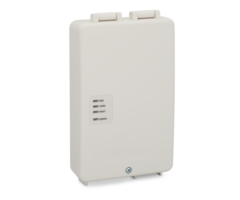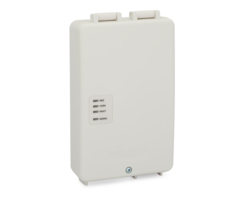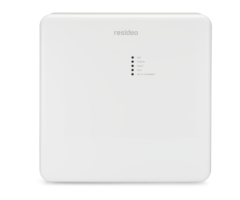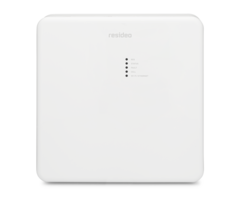How Do I Use an External Communicator with a Lynx L3000?
Connect an L3000 to an external ECP communicator with a LYNXGSMEXTCB cable. The harness plugs into the L3000. The loose wires connect to the communicator's terminals. The wire colors are easy to mix up since they do not follow the standard. Please pay close attention to the details below.

The L3000 or Lynx Plus, as it is also called, is an All-In-One alarm system from Honeywell. It features an LCD display and voice features. It has support for up to 40 wireless security sensors. Zone 01 on the L3000/LYNX Plus alarm control panel is set aside as a hardwired zone. Zones 02-25 are standard RF zones. Zones 26-41 are set aside as RF button zones, but can also be used as standard RF zones. It also supports the Total Connect 2.0 (TC2) remote interactive service when used with a compatible communicator.
To upgrade the L3000 to use an LTE cell communicator, there are two standard options. The two (2) compatible LTE communicators for the L3000 Systems are the Honeywell LTE-L3A (AT&T LTE) and the Honeywell LTE-L3V (Verizon LTE). Whether you choose AT&T or Verizon will have no impact on your monitoring expenses. You should decide based on which network (AT&T or Verizon) provides better cell reception in your area. The use of this option requires a cellular monitoring plan. For Alarm Grid customers, this is a Gold Plan (self or full) or higher, or a Cellular Alarm Monitoring plan for those not interested in using Total Connect 2.0.
What if you choose to do internet-only monitoring? There used to be an internet-only 7847i-L that could be mounted inside the L3000, as the LTE cellular modules do. That product is no longer available. So, if you are in a situation where you need to use internet-only alarm monitoring, this is where you would want to use an external AlarmNet communicator. For this setup, we recommend reading our faq on using a 7847i on a Lynx Plus L3000. This configuration will allow internet-only monitoring and will keep the option available to use Total Connect 2.0.
What if you wanted to use cellular and internet monitoring together? The LTE-IA and LTE-IV used to be ideal for this situation. Unfortunately, both of these communicators are discontinued. Since their discontinuation, there are no longer any ideal setups for this with the LYNX Plus. The LTEM-PA, LTEM-PV, LTEM-PIA, and LTEM-PIV communicators will work for a cellular-only monitoring plan. They will connect via ECP to the L3000, using the LYNXGSMEXTCB cable.
The Resideo LTEM-PA and Resideo LTEM-PV will not allow the needed programming options to enable Total Connect 2.0 on an L3000. They will, however, support the PROWIFI or PROWIFIZW modules. This allows them to use WIFI and Cellular for dual-path alarm communication. The LTEM-PIA, and LTEM-PIV communicators also do not allow the neccessary programming for TC2. They are also UL-985 listed and do not support TC2 if you are following UL guidelines. They do not support the PROWIFI or PROWIFIZW modules either.
The L3000 has an ECP connector on the board. This used to be along the right side of the board. Newer L3000s, now have this connector along the top of the board. This is where the LYNXGSMEXTCB cable plugs in.
ECP Connector located at the right side of the board:

ECP Connector located at the top of the board:

So, how is it done? Follow the steps below to connect an AlarmNet ECP communicator to the L3000.
1. Make the wire connections. Begin with a communicator and L3000 which are both powered completely down. Find the ECP communicator port on the L3000. Plug in the LYNXGSMEXTCB cable and make the proper connections to the AlarmNet communicator.
Important Note: The wire coming from the L3000 does not follow the standard color format when connecting to the communicator. Instead, use this as a guide:
- Black Wire = Positive (+)
- Red Wire = Negative (-)
- Green Wire = Data In
- Yellow Wire = Data Out
For example, if wiring to a 7847i, it would look like this.

If you do decide to use any one of the LTEM-PA, LTEM-PV, LTEM-PIA, or LTEM-PIV communicators, despite their inability to support TC2 with the L3000, then your connections would look as shown below.
Important Note: The LTEM-P communicators use their own DC transformer and do not require the use of V+ from the L3000 panel. This is why the black wire from the panel is not shown in the image below.
- Black Wire = Not Used
- Red Wire = Negative (-)
- Green Wire = RX
- Yellow Wire = TX

If wiring to a communicator that also uses an ECP wiring harness, rather than screw terminals, then you would need to use two (2) LYNXGSMEXTCB cables connected together. An example of this type of communicator is the LTEM-XA or the LTEM-XV. That connection would look like this:

2. Power up. After the connections are made, route wires according to your devices, and then power up. For the LTEM-P communicators, plug in the transformer before the battery. For all other equipment, plug in the battery first, then the transformers to apply power.
3. Program and Test. This step requires contacting your alarm company. They will need the mac and crc from your AlarmNet communicator to program it with AlarmNet 360. They will activate your account and facilitate all desired testing.
Did you find this answer useful?
We offer alarm monitoring as low as $10 / month
Click Here to Learn MoreRelated Products






Related Videos
- Answered
- Answered By
- Fred Daniels

